Big Bend
Ride RetrospectiveAsk someone who visited Six Flags over Texas in the 1970s about the ride they remember or miss the most, and there’s a good chance they’ll respond with the Big Bend roller coaster. This relatively short-lived roller coaster thrilled plenty of visitors over its troubled 8-year existence, but despite its removal over 30 years ago, the ride’s legend continues. Just mentioning “Big Bend” can bring both nostalgic memories and urban legends from those fortunate enough to experience it. In this Ride Retrospective we’ll learn about the Big Bend, sort fact from fiction, and understand why the ride was eventually removed.
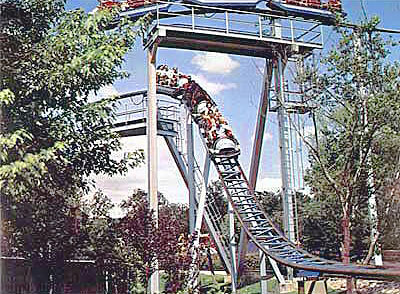
Background
The year was 1970 and Six Flags over Texas was looking to expand its thrill ride lineup. The park began planning a technologically advanced ride from German coaster designer and manufacturer Anton Schwarzkopf (who later created Shock Wave). Schwarzkopf had released a series of “Jet Star” roller coasters that packed big thrills despite their small footprint. Six Flags contracted the master coaster designer to create an evolved Jet Star coaster, coined a “Speedracer.” The Speedracer coasters differed from their predecessors by having larger layouts and trains of toboggan-style cars, rather than single cars. Construction soon began on the new coaster which was located in the Modern/USA section, essentially where Aquaman Power Wave is today.
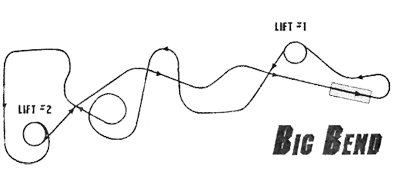
Big Bend Stats
| Ride Type: | Steel roller coaster |
| Years Operated: | 1971-1979 |
| Height: | 81 ft |
| Top Speed: | 52 mph |
| Length: | 2876 ft |
| Inversions: | 0 |
| Manufacturer: | Schwarzkopf |
| Duration: | 1 min, 38 sec |
| Location: | Modern/USA Section |
| Attraction Location Currently Occupied By: | Aquaman Splashdown, Pandemonium |
The Big Bend Experience
Six Flags over Texas debuted the Big Bend roller coaster for the 1971 season, named in honor of the national park of the same name. Like the Jet Star coasters that Speedracers evolved from, Big Bend focused on steep drops and tight, highly-banked turns. Its expanded layout allowed the trains to travel through foliage and over/near other attractions, further adding to the thrill.
Besides being a thrilling ride for its time, Big Bend was full of technological innovation as well. One such innovation was its electric spiraling lift hillsA lift hill is usually the first hill of a coaster that the train is pulled up. While traditional lift hills use a chain on a straight, inclined section of track, Big Bend utilized compact, spiraling lift hills to save room. A powered rail in the middle of the lift hills’ track sent electricity to motors on the trains that drove tires, pushing the trains up the spiraling lift hill. Unfortunately for Big Bend, these innovative lift hills ultimately contributed to its removal.
Separating Myths from Facts
Big Bend’s intense turns and drops inevitably led to numerous urban legends, such as the train jumping the track and killing passengers. While nobody ever actually died from the ride, the exaggerated stories turned the attraction into a legendary experience and gave bragging rights to those who dared to conquer the ride.
Such legends were likely the result of one real-life event where a passenger stood up during the ride and was promptly ejected from the train. Big Bend’s tight turns had strong positive Gs that technically made restraints unnecessary — the forces were enough to keep riders secure in the seats. The passenger who stood during the ride and was ejected was seriously injured but survived, and this event led to seatbelts being installed on the trains to discourage future behavior. This story probably morphed into the legends of greater accidents on Big Bend that continue even today.
Removing the Big Bend
Unfortunately for the park, Big Bend had two major faults that ultimately led to its removal. First, the coaster had a low rider throughput, allowing only about 600 riders per hour. In comparison, modern coasters can handle 1600 or more per hour. The ride initially opened with three-car trains. However when it was discovered that the weight of the trains put high stress on the track, the park removed a car from each train, further reducing capacity. When the low capacity issue combined with the fact that Big Bend was new and popular, the result was extremely long lines. So long, in fact, that guest services was often flooded with complaints about the excessive wait times.
The second major fault of Big Bend was its reputation as a mechanical nightmare by the maintenance department. The coaster’s high-tech electric lift hill had major reliability issues, resulting in large amounts of downtime and contributing even further to the guest complaints. The park soon discovered that keeping the electric motors and drive tires in each train running was a daunting challenge. When it rained, the tires would slip and the contact between the powered rail and motors would spark. In fact, Big Bend was down for mechanical problems so often, the railroad had two versions of the spiel — one for when the ride was running and one for when it was closed. The non-operating spiel jokingly told guests to look at the trains whizzing around the track, and when guests obviously saw no such activity, it then explained that the trains were too fast for the human eye to see.
Six Flags eventually decided that Big Bend’s low capacity and continual reliability problems were too much to handle. The park decided to remove the ride at the end of the 1979 season, a year after another Schwarzkopf roller coaster was installed — Shock Wave. Seeming to learn from past mistakes, Shock Wave was capable of running three trains, allowing for about 1100 riders per hour, and used the more traditional chain-powered lift hill.
Big Bend was transported to Six Flags over Mid-America (now Six Flags St. Louis) with intentions of rebuilding the ride there. Unfortunately by the time the park was ready to install the ride, the track had significantly corroded and was unusable. Big Bend’s track was eventually sold as scrap metal several years later.
Big Bend’s Legacy
Big Bend undoubtedly remains one of the most memorable attractions of Six Flags over Texas’ past. The ride’s intensity (especially for the 1970s) combined with its undying folklore has firmly implanted Big Bend into the minds of past park visitors.
Despite being removed over 30 years ago, current-day visitors can still see remnants of Big Bend in the form of concrete footers that formed the foundation for the ride’s supports. These footers can be viewed from a barely-used pathway that runs parallel to the park’s entrance road behind Aquaman Splashdown. Appropriately enough, this pathway is often called “Big Bend Walkway” by savvy employees and guests.
Although no one will ever get another Big Bend ride, not all is lost. Five years after Big Bend’s debut, a new theme park opened near Chicago named Marriott’s Great America. This new theme park introduced a Schwarzkopf “Speedracer” roller coaster very similar to Big Bend named “Willard’s Whizzer.” Unlike Big Bend, however, the park never removed the ride and has operated it continuously since its 1976 debut. Marriott’s Great America has since been purchased by Six Flags and renamed Six Flags Great America, and the coaster’s name has been shortened to “Whizzer.” Those reminiscing for one more Big Bend ride likely can’t get any closer than travelling to Illinois and taking a spin on the Whizzer.
Recommended Links
- Schwarzkopf Coaster Net – The de facto website about Schwarzkopf roller coasters not only has a page for Big Bend, but also a technical details page that explains the electric lift system used by the ride.
- Parktimes – The web’s premiere source for Six Flags over Texas history has plenty of Big Bend photos.
- RCDB: Big Bend – The Roller Coaster Database also has several good-quality Big Bend photos.
References
- Pantenburg, Michael. “Big Bend.” Schwarzkopf Coaster Net. Web. 07 Nov. 2010. http://schwarzkopf.coaster.net/ESbigbendGF.htm.
- “Big Bend (Six Flags Over Texas).” Roller Coaster DataBase. Web. 07 Nov. 2010. http://www.rcdb.com/1119.htm.
- “Six Flags over Texas Former Employee Forum.” Six Flags over Texas Former Employee Pages. Web. 07 Nov. 2010. http://www.sfot.net/sfot-forums/.
All Big Bend photos and images are copyright their original, respective owners. No claim of ownership is made by GuideToSFoT to any non-watermarked images in this article. Special thanks to Scott Yarbrough and Michael Hicks for permission to use their images.

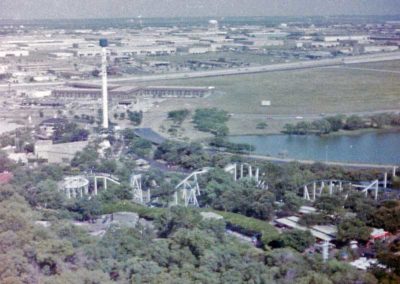


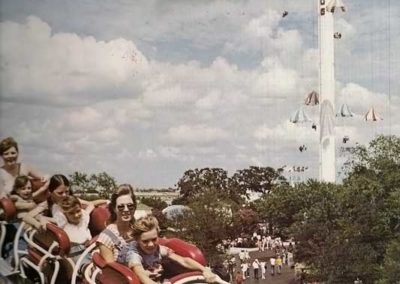
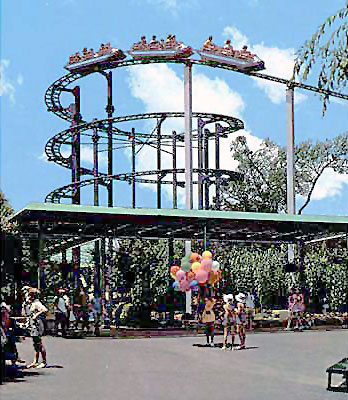
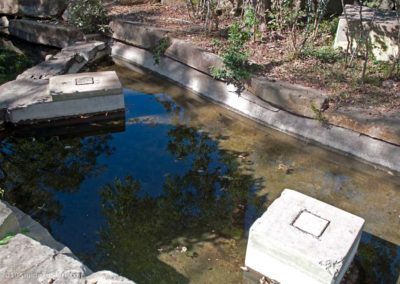
I rode it the year it opened and several years after. It was ALWAYS my fav ride. It was a BIG deal when it opened and this was long before the internet and Social Media to talk about it. Kids and teens waited hours to ride this ride and it WAS worth the wait! I have ALWAYS loved coasters and this will ALWAYS be my favorite one!
I rode big bend backwards in front. On first spirals I took off seat belt and turned around and held on. I turned back around on second set of spirals. If anyone out there reads this and remembers that please corroborate my story. It is true
I remember this ride very well, most especially the maintenance problems as I was riding it back in 1975 when it came to a sudden stop at the top of the twisted turns. I very vividly remember all of us being told to stay in our seats and the fire department came out. No one was hurt or killed but it scared the living daylights out of me and that was the last time I rode Big Bend. It was very fun but even at the tender age of 15 I did not want to take ever take another chance on a ride that so obviously had such issues as to warrant staying in my seat for well over 2 hours while the fire department checked out the ride. The worst part was that it was the beginning of the ride and we still had to ride it down!